Gear Reviews
Review – Arkham Abyss Tube Bass Preamp
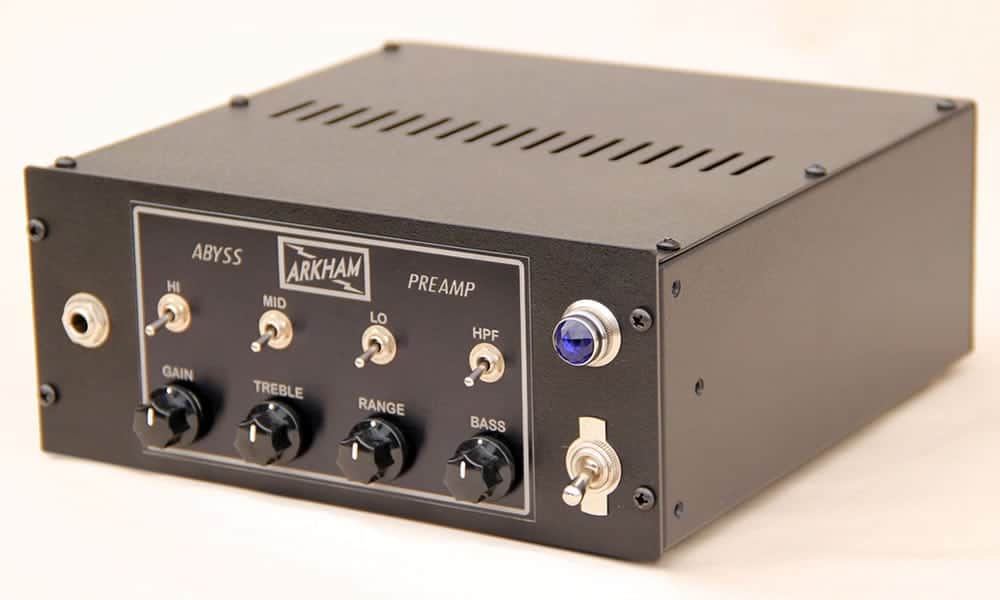
In the midst of today’s rapid-fire onslaught of newest and greatest products, it’s hard to stand out.
As is often the case, the way a new product cuts through the chatter is not with hyperbole and slick marketing, but when someone you know and trust to have great ears says “man, you gotta hear this thing”. That’s how I got hip to a tiny shop in Maine called Arkham Sound. And so of course, the unabashed tone hound in me was curious. When I contacted Micah Smaldone, owner and builder of Arkham, he was kind enough to not only put up with my excessive questions on the phone but send his Abyss preamp in the mail. What arrived was a handsome and robust looking tabletop preamp unit whose feature set and build quality had me interested from the moment I unboxed it.

A little about Arkham Sound:
Micah Smaldone is one of those guys who has been tinkering and experimenting with tube amps and audio equipment since he was a teenager. Originally an acoustic guitarist who in his youth, played in a punk rock band in Boston, Smaldone settled in Maine. “I built a preamp for myself around 10 years ago. I’d been recording an album and was having difficulty with the bass tracks. I cloned a B-15 in a tiny chassis and immediately had the right tone. I felt it worked so well as a standalone unit, I built a few and put them on Reverb or eBay … It took off when someone posted on TalkBass, and I began building them for people. The first one was called the Octling.”
Fast forward to the current state of Arkham Sound.
Micah is busy hand building a line of “Ampeg inspired” preamps for the needs of modern players. I put quotes around “Ampeg inspired” partly because they’re his words, and partly because I find the Abyss to be capable of a wider range of tones and sonic palettes. He may be using Ampeg’s footprint as a starting point, but a couple knob turns jumps the Arkham in to a much broader sonic pool. The Arkham line consists of 3 preamps, the flagship Zephyr which is a 1u rack preamp which has all of the features of the Abyss, with the addition of a “DI level out” control, a “Pre-out” master volume control, and a Mute switch. The Bullet pre is the no-frills version of the Arkham line, housed in a slick ammunition case, and features a 2 band EQ with boost switches for “lo”, “mid” and “hi” bands.
When I unboxed the Abyss, I was immediately impressed by its super robust build quality and industrial/military clean and no-nonsense aesthetic.
It is somehow elegant and utilitarian at the same time. All of the knobs have that smooth resistance I love, and the hefty baseball bat switches have a high-quality feel. The 12ax7 based preamp can be used as a tabletop unit or mounted in a ½ rack with rack ears.

Looking at the feature set, the Abyss has some familiar items and a few unique touches.

The input gain is about what you’d expect. Run it on the low end for clean gain, crank it up above 3 o’clock and you get into overdriven tones. Running into a power amp with a master volume control, I was able to set it right at the threshold where playing with a light touch was clean and clear, and digging in yielded some very smooth and desirable breakup. The James Tonestack is essentially a passive Baxandall style tone control circuit and has a very familiar and musical sound to its range. The treble and bass knob are exceptionally well placed for musicality and versatility. The hi switch adds a “bright cap” to open up the highs, and the lo switch adds a meaty bump around 80hz, while the mid switch offers a broad bump around 250 Hz, perfect for helping the bass pop through a busy mix.

The last two controls are where things get interesting. The Abyss features something called a “Range” control. At first, it’s pretty subtle, but the more I listen to it, the more ingenious I find it. Essentially, it shifts the “tone stack midpoint”, moving the preamps sonic fingerprint up or down to the frequency spectrum to taste, from 150Hz to 1KHz. I found the sweet spot to be somewhere around 2 o’clock with my rig and according to my tastes, but there is a lot to unpack in that little knob and its relationship to the bass and treble EQ settings, and it’s safe to say that most people will hone in on their happy place pretty quick, and find a great starting point for any additional tone shaping.
The last feature I’ll go over from the front panel is the HPF or “High Pass Filter”.
High pass filters are nothing new, but in the last few years, bass players have started to really get hip to what they do. At their best, they remove subsonic low-frequency rumble which cleans up your stage sound, pockets the low end in a usable way, and reduces the workload on your amp, since it cuts the unnecessary subsonic low frequencies that can hog the power in amplifiers. I have been using an HPF on my pedalboard for years, and it’s become a “cold dead hands” device for my live rig. But I digress. Anyways, the HPF on the Arkham is set kind of high on first listen. With a steep cutoff around 150Hz, it does tend to thin out the low end quite a bit. However, the Arkham seems to be made for a favorite trick of producers and players: using an HPF in combination with bass boost. By sharply cutting the lows with an HPF and adding them back in with large amounts of EQ (via the bass knob and bass boost switch), you get a less linear and somewhat more energized low end to the sound, which can sound more like a tube power amp being pushed, than a clean tube preamp. Personally, I preferred the non-HPF’d sound, opting for the leaner, cleaner yet big low end. But very cool to have these different flavors in one relatively simple box. (Arkham responds: the cutoff point for the HPF can be set lower if a customer prefers)
The output section of the Abyss is fairly straightforward.
There is a line level ¼” output for connecting to an amplifier, as well as a DI output, which features a “hefty Edcor transformer for full frequency response”. I had good success plugging the ¼” output into the front end of a bass amp, as well as a power amp input. The Arkham provides plenty of output and delivers its signature vintage-inspired tone in spades. I like to think of it as “vintage and then some”

As they always say, the proof is in the pudding. Great looking, well designed and handsomely outfitted doesn’t really mean much if it doesn’t sound great too. I took the Abyss to a handful of gigs, including a rock power trio brewery gig, and the Abyss not only delivered, it excelled. I loved its plump and massive yet firm low end and the full-throated and commanding midrange that sounded like a wall of thickness, but somehow magically didn’t get peaky, bloated or unbalanced. Sometimes when I hear a piece of gear with a thick low midrange, it can create some buildup around those frequencies resulting in a bloated or boggy low mid profile, but the Arkham seems to be voiced just right, without any of those undesired characteristics. What’s more, the Range knob allows you to move the tone stacks profile up or down in frequency range, to tailor the Abyss’s luscious sonic footprint for the particular needs of your bass, cabinet, room, or taste.

In addition to my own sense of auditory satisfaction, I was surprised by how other people responded to it.
Band members that I’ve played dozens of gigs with remarked at how great the bass sounded on stage, and asked about what kind of magic box I’m using. Audience members, known to be painfully oblivious to good bass tone, came up to me asking about my rig and remarking how good the bass sounded in the room. I take that as a strong indicator, as their obliviousness can be a good reference point for an unbiased opinion.
All in all, it’s easy to see that I was very impressed with the Arkham.
While there is really no shortage of cool pre-amplification and DI options on the market right now, there are always standouts. I have a short list of tube DI’s/preamps that I think are the bee’s knees, and the Arkham is firmly planted on that small pedestal. It is easy to use, well built, sounds fantastic and is reasonably priced for what it is and what it does. At $700, it competes strongly with some of the popular and hip tube preamps du jour. And the best news? Arkham is in the process of designing an integrated head, combining all the features and tones of the Abyss with an ultra-high-powered, lightweight, state of the art class D power section. Also on the bench is an Arkham preamp in pedal format.
For more information on sales and lots of interesting technical info, visit Arkham’s website and follow them on Facebook.
Bass Videos
String Instrument Humidifiers
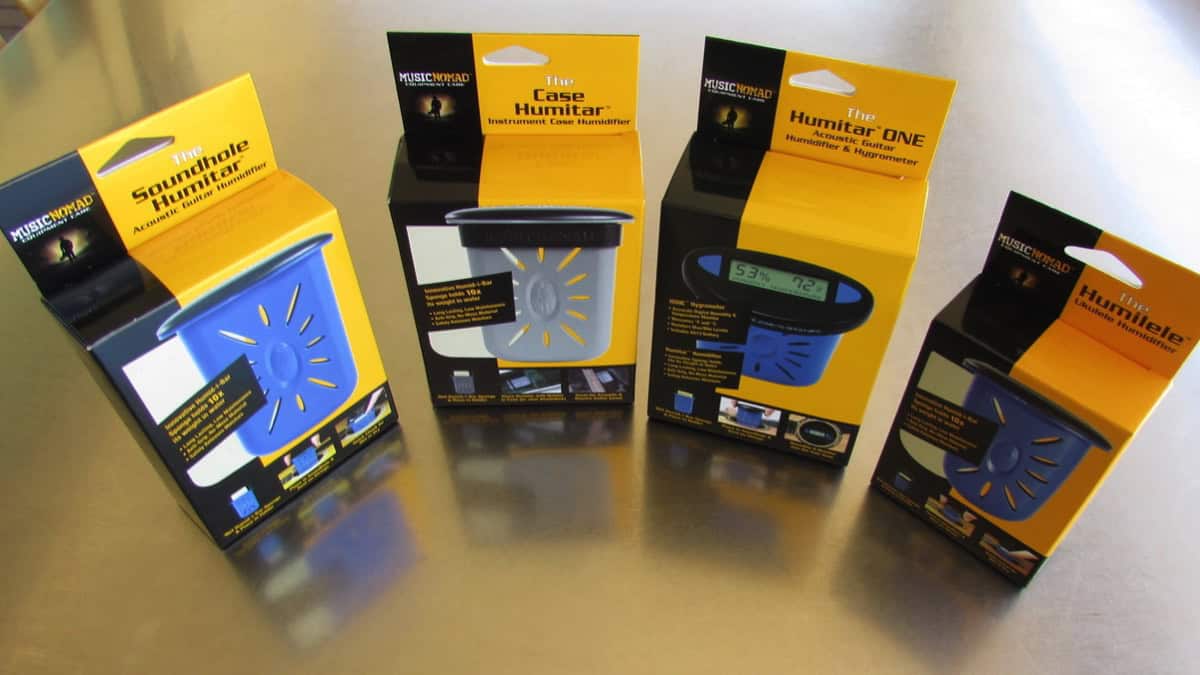
String Instrument Humidifiers
After living in some very humid parts of the country for decades, we moved to a dryer, much sunnier location. As a result, I started noticing some fret sprout on my string instruments and recently did a video on fret sprout correction.
It occurred to me that I should take a more preventative approach to string instrument humidification. Of course, I turned to my instrument maintenance experts, Music Nomad Equipment Care, for a solution and they suggested their Humitar series. (Note: They sent two press samples and I purchased the remainder online.)
Join me as I look at these useful tools for keeping my string instruments in tip-top condition.
The Humitar series is available online at Music Nomad Equipment Care, as well as Amazon.com
Bass Videos
Review: CrystalBright Rombo Picks
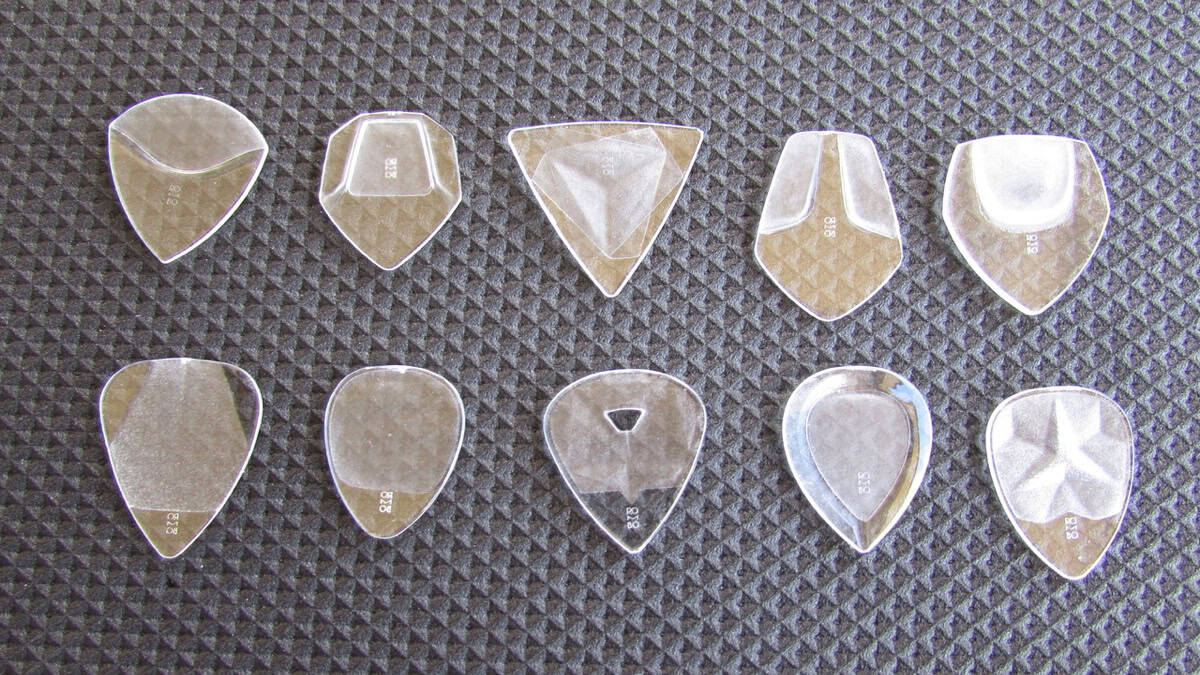
CrystalBright Rombo Picks
PR SamplePlaying bass with a pick is still a touchy subject in our community. I believe you should be able to use whatever you need to get your sound. Even though I mostly play with my fingers, I like to check out innovative new picks that might have something new to offer, sonically speaking.
Judith and Carlos from Rombo recently contacted me about a new material called CrystalBright that they have been researching for the last 12 months and offered to send some prototype picks. After trying them out, I put together this video with my findings.
For more info check out @rombopicks
Gear
New Joe Dart Bass From Sterling By Music Man

Sterling by Music Man introduces the Joe Dart Artist Series Bass (“Joe Dart”), named after and designed in collaboration with the celebrated Vulfpeck bassist.
Above photo credit: JORDAN THIBEAUX
This highly-anticipated model marks the debut of the Dart bass in the Sterling by Music Man lineup, paying homage to the Ernie Ball Music Man original that all funk players know and love. The bass embodies many of the original model’s distinctive features, from its iconic minimalist design to the passive electronics.

The design process prioritized reliability, playability, and accessibility at the forefront. Constructed from the timeless Sterling body, the Dart features a slightly smaller neck profile, offering a clean tone within a comfortable package. The body is crafted from soft maple wood for clarity and warmth while the natural finish emphasizes the simple yet unique look.
Engineered for straightforward performance, this passive bass features a ceramic humbucking bridge pickup and a single ‘toaster’ knob for volume control. Reliable with a classic tone, it’s perfect for playing in the pocket. The Dart is strung with the all-new Ernie Ball Stainless Steel Flatwound Electric Bass Strings for the smoothest feel and a mellow sound.

The Sterling by Music Man Joe Dart Bass is a special “Timed Edition” release, exclusively available for order on the Sterling by Music Man website for just one month. Each bass is made to order, with the window closing on May 31st and shipping starting in November. A dedicated countdown timer will indicate the remaining time for purchase on the product page. Additionally, the back of the headstock will be marked with a “2024 Crop” stamp to commemorate the harvest year for this special, one-of-a-kind release.
The Joe Dart Bass is priced at $399.99 (MAP) and can be ordered globally at https://sterlingbymusicman.com/products/joe-dart.
To learn more about Joe Dart, visit the official Vulfpeck artist site here https://www.vulfpeck.com/.
Gear Reviews
The Frank Brocklehurst 6-String Fretless Bass Build
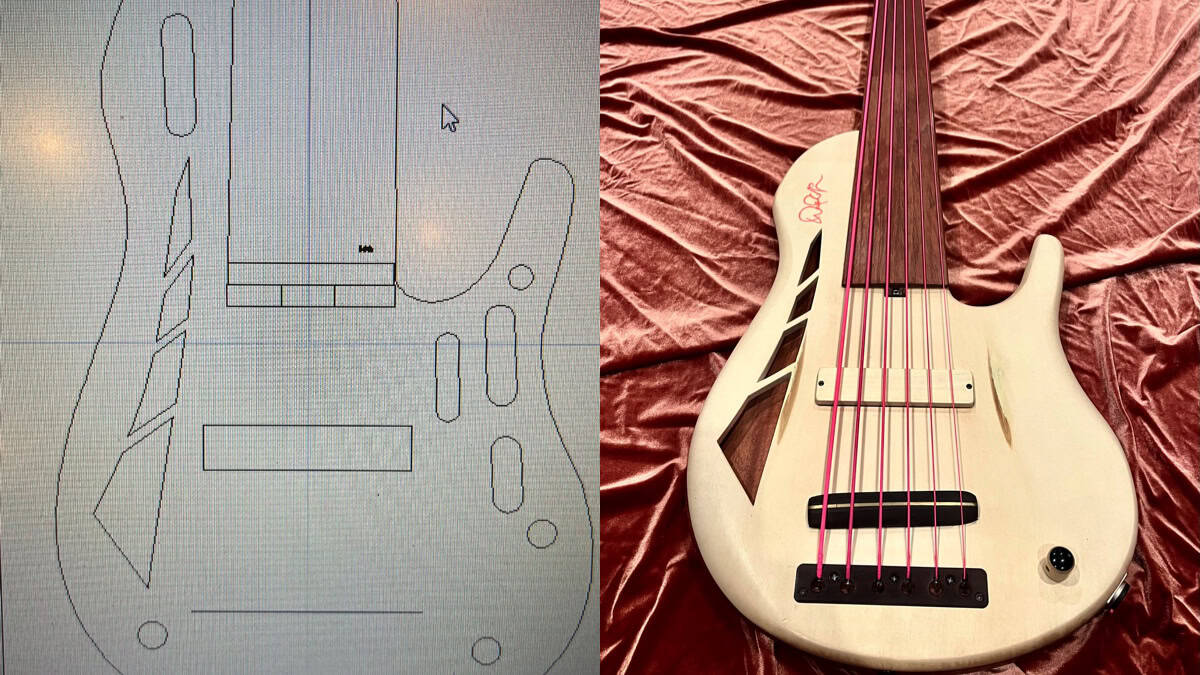
A few months ago, my Ken Bebensee 6-string fretted bass needed some TLC. You know, the one rocking those Pink Neon strings! I scoured my Connecticut neighborhood for a top-notch luthier and got pointed to Frank Brocklehurst, F Brock Music. He swung by my place, scooped up the bass, and boom, returned it the next day, good as new. Not only that, he showed up with a custom 5-string fretted bass that blew me away. I couldn’t resist asking if he could whip up a 6-string fretless for me.
Alright, let’s break down the process here. We’ve got our raw materials: Mahogany, Maple, and Holly. Fun fact – the Mahogany and Maple have been chilling in the wood vault for a solid 13 years. Frank is serious about his wood; they buy it, stash it away, and keep an eye on it to make sure it’s stable.

First up, they’re tackling the Mahogany. Frank glues it together, then lets it sit for a few days to let everything settle and the glue to fully dry. After that, it’s onto the thickness planer and sander to get it nice and flat for the CNC machine. The CNC machine’s the real star here – it’s gonna carve out the body chambers and volume control cavity like a pro.

While the Mahogany’s doing its thing, Frank goes onto the neck core. Three pieces of quartersawn maple are coming together for this bad boy. Quartersawn means the grain’s going vertical. He is also sneaking in some graphite rods under the fingerboard for stability and to avoid any dead spots. The truss rod is going to be two-way adjustable, and the CNC machine’s doing its magic to make sure everything’s just right.

Now, onto the design phase. Frank uses CAD software to plan out the body shape, neck pocket, chambering, and those cool f-holes. I had this idea for trapezoid F-holes, just to do something different. The CAD software also helps us map out the neck shape, graphite channels, and truss-rod channel with pinpoint accuracy.

Once everything’s planned out, it’s CNC time again. Frank cuts out the body outline, neck pocket, and the trapezoid F-holes. Then it’s a mix of hand sanding and power tools to get that neck just how we like it. Oh, and those f holes? We’re going for trapezoids of different sizes – gotta keep things interesting.

Next step: gluing that neck into the pocket with some old-school hide glue. It’s got great tonal transfer and can be taken apart later if needed. Then it’s onto hand-carving that neck-body transition.

For the custom-made bridge, Frank uses brass for definition and Ebony for tonal transfer and that warm, woody sound.

BTW, for tunes, Frank went with Hipshot Ultralights with a D Tuner on the low B. This way I can drop to a low A which is a wonderful tone particularly if you are doing any demolition around your house!
Now it’s time for the side dots. Typically, on most basses, these dots sit right in the middle of the frets. But with this bass, they’re placed around the 1st, 3rd, 5th, 7th, 9th, and 12th frets.

Frank’s got his pickup hookup. Since the pickup he was building wasn’t ready, he popped in a Nordstrand blade to give it a whirl.

It sounded good, but I was itching for that single-coil vibe! And speaking of pickups, Frank showed me the Holly cover he was cutting to match, along with all the pink wire – talk about attention to detail!

A couple of things, while it is important for me to go passive, it is equally important for me to just go with a volume knob. Tone knobs are really just low-pass filters and the less in the way of a pure sound for me, the better.
Finally, it’s string time! As usual, I went for the DR Pink Neon strings. Hey, I even have matching pink Cons…Both low tops and high!

Once we’ve got everything tuned up and settled, we’ll give it a day or two and then tweak that truss rod as needed. And voila, we’ve got ourselves a custom-made bass ready to rock and roll.

I want to thank Frank Brocklehurst for creating this 6 string beast for me.
Gear Reviews
Review Transcript: BITE Custom Bass – The Black Knight PP Bass
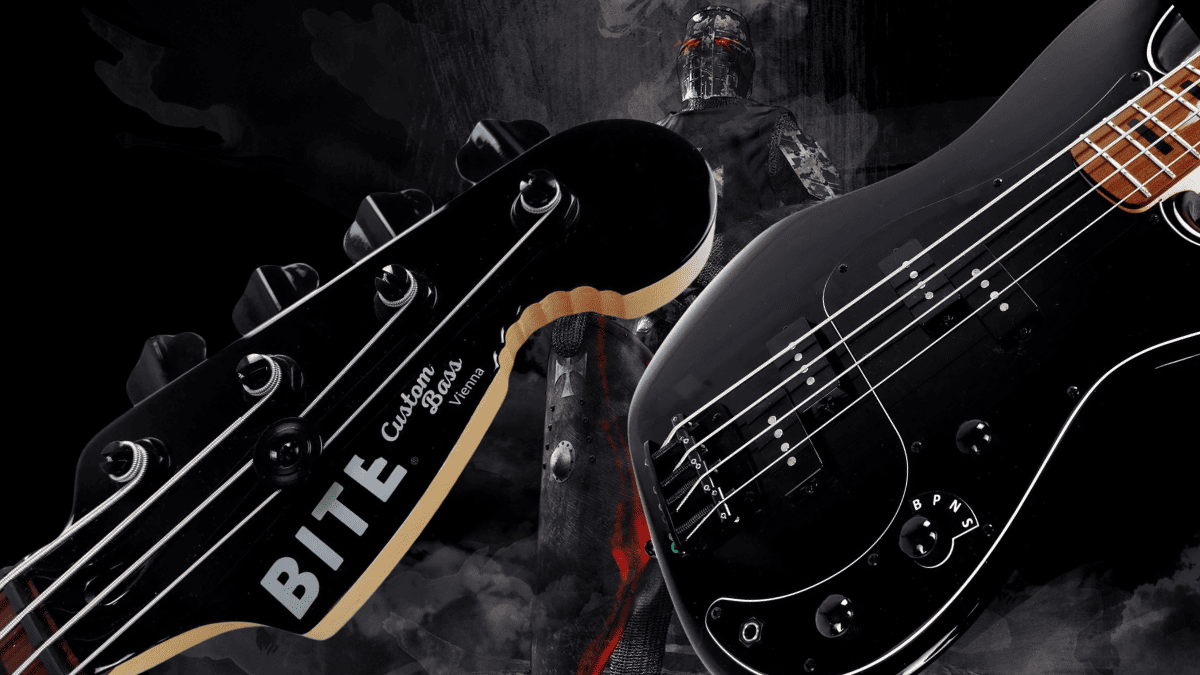
This is a written transcript of our video review of the BITE Custom Bass Black Knight PP Bass originally published on March 4, 2024
BITE Custom Bass – The Black Knight PP Bass Review…
Bass Musician Magazine did a review on a Steampunk bass from BITE Guitars about three years ago, it was an amazing instrument, and we were very impressed. Now we’re happy to bring you another BITE bass, the Black Knight PP.

Everybody needs a P-type bass, it’s the standard of bass. If you’re recording, they want you to have a P bass. So why not have something that gives you a little more by having two instead of one P pickup. That’s the idea of this bass, it’s the first thing that leaps out: the double P pickup configuration.

Installing two of their 1000 millivolt split-coil pickups, BITE then went one step further and wired them up in a 4-way parallel/series circuit, a look at the controls reveal a 4-way rotary selector:
The first position, marked “B”, gives you the bridge pickup by itself.
The second position, marked “P”, gives you the bridge and neck pickups in parallel mode, that’s the traditional J-type circuit, it reduces output due to the physical law of parallel circuits.
Position number 3 is marked “N”, it gives you the neck pickup by itself.
And finally, number 4, marked “S”, gives your bridge and neck in a series (humbucking) mode which adds up resistances and thus boosts output. The other two controls are master volume and master tone.

What’s more, like every BITE bass, this one also has a reinforced headstock heel designed to give it extra output and sustain. The BITE website features a graph and explanation of what they have done to the heel, as compared to traditional headstocks.

A look at the body reveals a beautiful Black Blast body finish and underneath that we have alder wood. The bass has a matching headstock with a 4-in-line tuner setup and the traditional bite out of it, so everybody will know what kind of bass you’re playing. The pickguard is 3-ply black, the neck is vintage tinted hard maple and it has a satin speed finish at the back which keeps your thumb from sticking.
On top of that, there’s a clear-coated roasted black locust fretboard with black blocks marking the frets. The nut is a black Graph Tec nut, we’ve got diamond dome control knobs, and the tuners are lightweight compacts with cloverleaf buttons and a 1:17 ratio precision gear. The bridge is a Gotoh brass bridge with 19-millimeter string spacing.
Overall measurements: we’ve got a standard 34″ scale, a 1.65″ width nut and a C neck profile. This bass weighs 8.2 pounds, or 3,7 kilograms for our metric friends, and it uses standard 18% nickel silver frets.
Taking a closer look at the sound, this bass is a joy to play. The BITE proprietary 1000 millivolt pickups deliver an extraordinary amount of output which is surprising considering this is a passive instrument. You may even want to set your amp to active mode because of all of the juice you’re getting out of this guy.
The tonal possibilities are very versatile, it’s a straight P if you want but also much more with those different arrangements of the circuitry. So why have multiple basses when you’ve got one that can give you your basic P plus a lot more?
To sum it up, the Black Knight PP is an amazing instrument. The attention to detail that BITE puts into their basses is second to none. This bass is also amazingly balanced and gorgeous to hold and feel with the satin neck finish.
For more information, visit online at bite.guitars/product/black-knight-pp



















